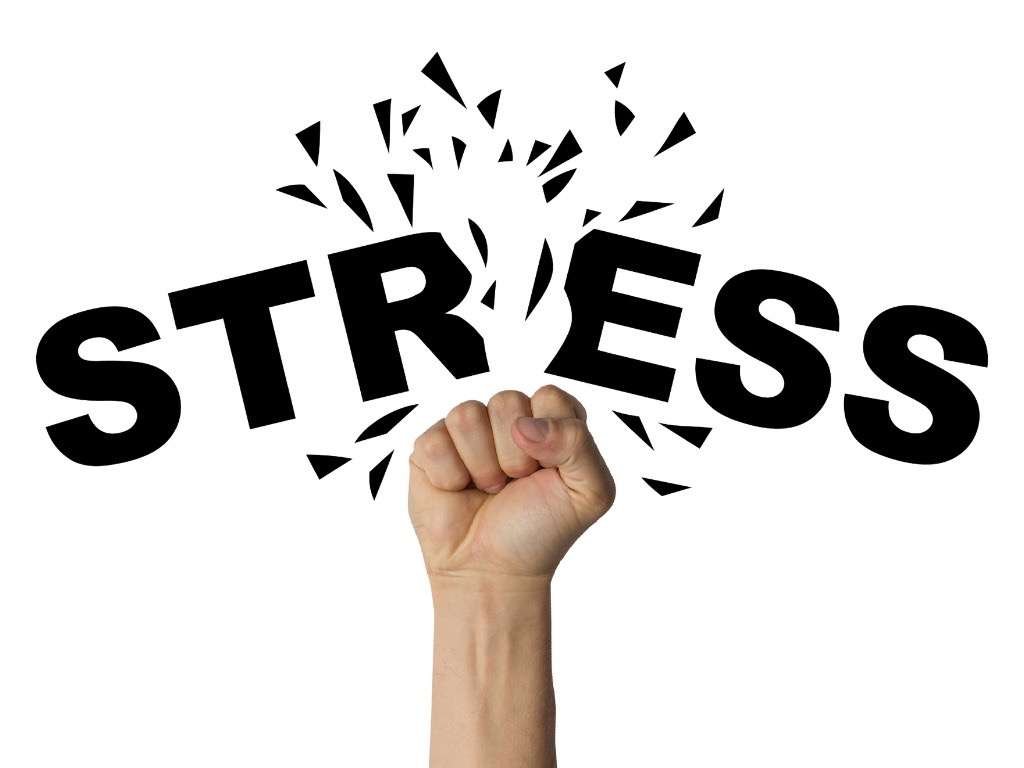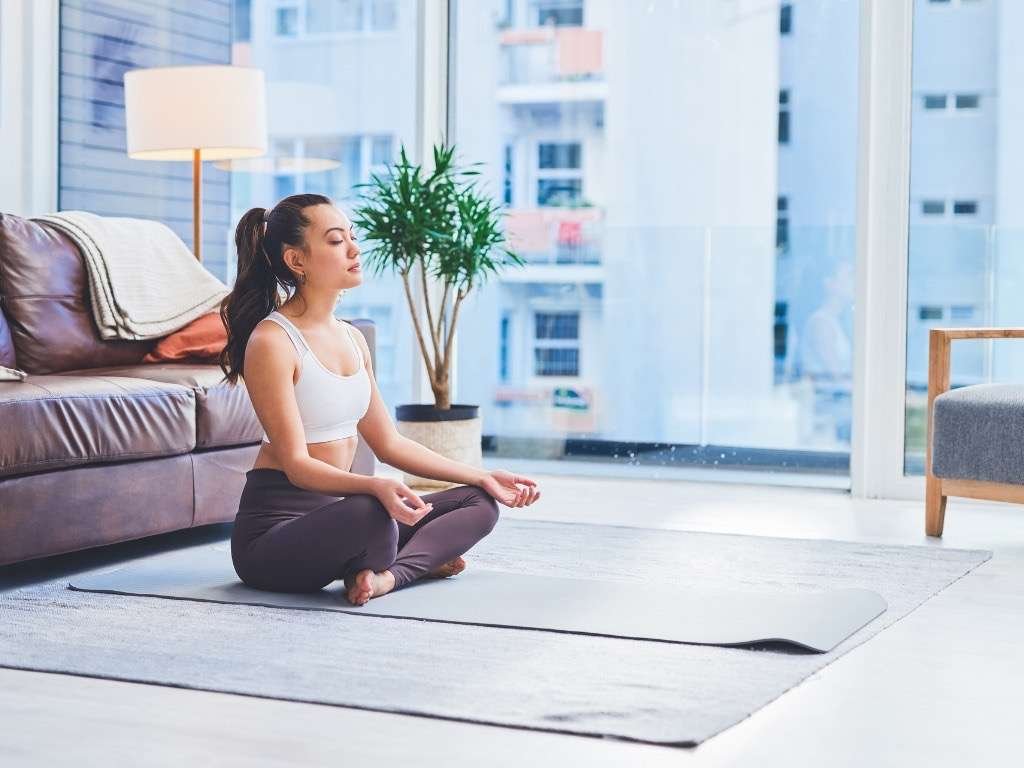What if the best ways to manage stress and anxiety are simpler—and closer to your daily routine—than you think?
You’re about to learn seven practical steps. These come from the CDC and peer-reviewed research. They focus on small actions like movement, mindful minutes, steady sleep, and smarter daily habits. Each one supports your nervous system and helps you feel more in control.
Managing Stress and Anxiety is not a one-time fix. Chronic stress can raise risks for heart disease, anxiety disorders, and depression. But steady routines protect your health over time. In this guide, you’ll find clear, doable strategies you can start today and keep for good.
If you or someone you know is struggling or in crisis, contact the 988 Suicide & Crisis Lifeline. Call, text, or chat at 988lifeline.org. Help is free, confidential, and available 24/7.

Understanding Stress, Anxiety, and Their Health Impact
You face challenges at work, school, and home every week. Knowing how to manage stress and anxiety starts with clear definitions. You can use this insight to pick daily habits for stress and anxiety relief that fit your needs and routines.
What stress is and how it differs from anxiety and depression
Stress is your body’s short-term response to pressure. It can sharpen focus and help you solve problems. When the pressure fades, your system should settle.
Anxiety is more persistent. It often shows up as ongoing worry or fear, even when a threat is not clear. Depression involves low mood, loss of interest, and changes in sleep or appetite. Managing Stress and Anxiety means spotting which one you’re facing so you can act smart.
Common signs: sleep problems, trouble concentrating, headaches, and mood changes
You might notice restless nights, vivid dreams, or early wake-ups. Headaches, stomach flips, or tense shoulders can follow a hard day.
Mind fog can slow decisions. You may feel irritable, flat, or on edge. These cues help you plan how to manage stress and anxiety with daily habits for stress and anxiety relief you can keep.
Risks of chronic stress: heart disease, anxiety disorders, and depression
When stress lingers, your body stays in high alert. Over time, that strain can raise blood pressure and burden the heart.
Chronic stress also raises the odds of anxiety disorders and depression. Recognizing this link supports Managing Stress and Anxiety before it snowballs.
Why vulnerability varies: genetics, social support, coping style, personality, discrimination, and trauma
Your stress load is not only about willpower. Family history can play a role. So can your coping style and personality—whether you lean toward perfectionism or flexibility.
Social support matters. Strong ties with friends, family, or community groups can buffer hard weeks. Discrimination based on race, gender, perceived gender, LGBTQIA+ identity, or income adds strain many people carry.
Past trauma and job demands can amplify reactivity. When you map your own patterns, you can choose daily habits for stress and anxiety relief tailored to you and sharpen how to manage stress and anxiety day to day.
Managing Stress and Anxiety
You can make steady gains with small, daily steps. Use practical tips for managing stress and anxiety that fit your life and build from there. The best ways to manage stress and anxiety start with routines you can keep.
Proven lifestyle strategies you can start today
Start with movement. Aim for 150 minutes of moderate activity each week, plus two days of muscle work. Short walks or easy bike rides still count, and they add up fast.
Add a simple mindfulness or meditation habit. Two to five minutes can help you reset. Pair that with whole-food meals and a steady sleep schedule to support Managing Stress and Anxiety throughout your week.
Use breath to calm your body. Try diaphragmatic breathing or box breathing to lower heart rate. Limit evening screen time to improve sleep, and set clear boundaries so your calendar serves your health.
Round out your toolkit with yoga, journaling, and gratitude. Spend time outdoors and with pets for a lift in mood and routine activity. These are practical tips for managing stress and anxiety you can start now.
When self-care helps and when to seek professional treatment
Self-care often eases daily strain, but it is not a stand-in for clinical care. If symptoms persist for weeks, disrupt work or school, or grow worse, reach out to a licensed therapist, psychologist, or psychiatrist.
Use healthy coping and avoid turning to more alcohol or other substances. Evidence-based care—such as cognitive behavioral therapy or medication from your clinician—can be among the best ways to manage stress and anxiety when self-care is not enough.
Safety note: crisis support via 988 Lifeline (call/text/chat)
If you or someone you know is struggling or in crisis, call or text 988, or chat via the Lifeline for free, confidential help 24/7/365. Stay with the person, reduce access to means, and connect to support right away.

Evidence-Based Daily Habits that Calm Your Nervous System
You can train your body to reset faster after a hard day. Start simple routines to help with stress and anxiety. These habits fit into your daily life and help you manage stress and anxiety.
Move your body: CDC guidance on weekly activity and stress relief
The CDC says do 150 minutes of moderate activity weekly and two strength days. Short activities count too. Try a 20–30 minute walk, bike ride, or light dumbbells at home.
Studies on college students showed two aerobic sessions a week can lower stress. Start slow if you’re new to exercise. Choose activities you enjoy so you stick with them.
Eat for steadier mood: whole foods, fewer ultra-processed foods, and key nutrients
Ultra-processed foods and added sugar can increase stress. Whole foods help balance your mood. Eat vegetables, fruits, beans, fish, nuts, and seeds.
Focus on omega-3s from salmon or walnuts, leafy greens, whole grains, and magnesium and B vitamins. Try chicken and squash bake, quinoa with green beans and feta, orzo and white bean soup, summer roll bowls, and smoothies with whole ingredients.
Sleep hygiene essentials: consistent schedule and less evening screen time
Aim for 7 or more hours of sleep nightly. Keep the same sleep and wake times, even on weekends. Dim lights and turn off devices an hour before bed to help with melatonin.
Poor sleep makes you more stressed and anxious. A calm night helps you have a better day, making your stress relief habits stronger.
Mindfulness and meditation: brief, consistent practice to ease stress and anxiety
Start with 5–10 minutes of daily practice. Focus on breath or body sensations. Mindfulness-based cognitive therapy combines attention training with coping skills.
Apps like Headspace and Calm can help guide you. Over time, you’ll notice and handle worries better.
Deep breathing techniques: diaphragmatic and box breathing to lower heart rate
Place a hand on your belly and inhale so it rises; exhale slowly. This signals safety to your nervous system and relaxes your chest and neck.
For box breathing, inhale for 4, hold 4, exhale 4, hold 4. Repeat for a few minutes. Use it before meetings, while commuting, or at bedtime.
Stack one small action onto another. A walk, a balanced plate, good sleep, a mindful pause, and slow breathing create a steady rhythm your body trusts.
Natural and Practical Ways to Reduce Triggers
Reducing daily stress can be done by removing common triggers. These methods work best with small, consistent habits. Here are some tips to help manage stress and anxiety.
Minimize screen time to improve sleep and reduce perceived stress
Phones and endless feeds can keep your brain active at night. Set app limits, silence push alerts, and charge your phone outside the bedroom. A 60-minute wind-down without screens helps your body produce melatonin.
Choose what you watch and read carefully. Check news at set times, not all day. Mute keywords and turn off autoplay to lower emotional load.
Set boundaries and say no to prevent overload and burnout
Protect your calendar. Batch meetings, block focus hours, and decline nonessential tasks. A short script like, “I can’t take this on right now,” is clear and kind.
At home, share chores and set device-free meals. Boundaries free time and energy for priorities that matter.
Journaling and gratitude to reframe thoughts and boost resilience
Use a notebook or a guided journal to unpack stressors. Write what happened, how you felt, and one helpful next step. This simple act organizes your mind.
Each night, list three specific moments you’re grateful for. Over time, this shifts attention from threat to support, a core aim in Managing Stress and Anxiety.
Limit caffeine and support with supplements responsibly (talk to your doctor)
Keep caffeine under about 400 mg per day. Swap late coffee for matcha, chai, or herbal tea to protect sleep. Try a protein smoothie with fiber for steady energy.
Some people benefit from magnesium when deficient, but supplements vary. Always talk with your doctor before you start anything new. Avoid using alcohol or non‑prescribed drugs to cope.
| Trigger | What to Change | Simple Habit | Why It Helps |
|---|---|---|---|
| Late-night scrolling | Cut screens 60 minutes before bed | Set a phone curfew and use Do Not Disturb | Improves sleep depth and lowers perceived stress |
| Overloaded schedule | Say no to low-impact tasks | Use a one-line boundary script | Prevents burnout and protects focus |
| Racing thoughts | Journal and practice gratitude | 3 lines nightly: event, feeling, next step | Reframes worries and builds resilience |
| Jitters and poor sleep | Limit caffeine; consider guided swaps | Move last coffee to before noon | Reduces anxiety symptoms and supports rest |
| Unhealthy coping | Limit alcohol; avoid non‑prescribed drugs | Track intake and set weekly caps | Stabilizes mood and improves recovery |
Use these natural ways to manage stress and anxiety as daily guardrails. Small, consistent choices become powerful tips for managing stress and anxiety and keep you aligned with Managing Stress and Anxiety goals.

Social Connection and Nature for Resilience
Building resilience is easier when you mix strong bonds with time outside. This mix helps manage stress and anxiety in a way that feels real and doable.
Start small. Find natural ways to handle stress and anxiety that you can keep up with. Then, build daily habits that fit your life.
Lean on loved ones and community supports to buffer stress
Keep in touch with people who listen well. Call a friend, text a sibling, or meet a neighbor for coffee. Sharing your thoughts makes you feel seen and can calm your body.
Expand your circle with groups that share your interests. Join a local class, a sports team, a faith group, or help out at Feeding America. These connections help manage stress and anxiety.
Companionship from pets: oxytocin, purpose, and daily activity
Time with pets can release oxytocin and lower cortisol. A short walk with your dog or a calm grooming session with your cat adds structure and warmth.
Adopt routines that help manage stress and anxiety. Feed, play, and walk your pet at set times. These simple habits provide a steady sense of relief.
Get outdoors: even 10 minutes in green spaces can lower perceived stress
Take a brief break in a park, arboretum, or botanical garden. Ten quiet minutes among nature can lift your mood and sharpen your focus.
In cities, look for small parks, riverwalks, or rooftop gardens. Pair this with slow breathing to manage stress and anxiety without adding complexity.
Structured approaches: yoga, CBT skills, and scheduled breaks
Yoga combines movement and breath to calm your nervous system. Try a short flow on YouTube from brands like Alo Moves or Down Dog to fit your busy schedule.
Use core CBT skills: spot a catastrophic thought, test the evidence, and replace it with a balanced view. Add the Pomodoro Technique—25 minutes on, 5 off—to reduce overload and keep your stress management on track.
| Strategy | What to Do | Why It Helps | When to Use |
|---|---|---|---|
| Social Check-Ins | Schedule two 15-minute calls per week with trusted friends or family | Buffers stress through support and perspective | After tough days or before big events |
| Pet Routine | 10-minute play + 20-minute walk at set times | Boosts oxytocin, adds movement and purpose | Morning and early evening |
| Nature Micro-Break | 10 minutes in a park or garden without your phone | Lowers perceived stress and mental fatigue | Midday slump or after meetings |
| Yoga Reset | Short guided flow or restorative poses | Steadies breath, eases muscle tension | Late afternoon or pre-bed |
| CBT Thought Reframe | Write the worry, test evidence, craft a balanced statement | Reduces catastrophizing and rumination | When anxious thoughts spike |
| Pomodoro Rhythm | 25 minutes focus + 5 minutes rest, repeat 3–4 times | Prevents overload, supports daily habits for stress and anxiety relief | During heavy work or study blocks |
Conclusion
You have many tools to help manage stress and anxiety. Start with daily movement and whole-food meals. Also, get enough sleep and practice mindfulness or meditation.
Try deep breathing to calm your heart rate. These methods work well together and can fit into your daily routine.
Try to avoid triggers when you can. Reduce screen time in the evening and set clear boundaries. Use journaling and gratitude to keep your thoughts steady.
Limit caffeine and talk to your doctor before trying supplements. This approach offers a simple way to manage stress and anxiety without feeling overwhelmed.
Build resilience by connecting with supportive people and places. Lean on family, friends, and your community. Spending time with pets can also improve your mood and add structure to your day.
Make sure to spend at least 10 minutes outside in green spaces. Use structured skills like yoga and CBT techniques, and take scheduled breaks. Watch for signs like poor sleep, trouble focusing, headaches, or mood shifts, and address them early.
Make your plan fit your life and history, including genetics and job demands. Keep up with medical care and avoid substance misuse. If symptoms last or disrupt your daily life, seek professional help.
In a crisis, call or text 988 or visit 988lifeline.org for 24/7 support. With steady habits and timely care, you can master managing stress and anxiety for the long term.
FAQ
What is stress, and how is it different from anxiety or depression?
Stress is how your body reacts to challenges. It helps you focus in the short term. Anxiety and depression are mental health issues that last longer and affect daily life. Unmanaged stress can lead to anxiety or depression, but they are not the same.
What are common signs of stress I should watch for?
Look out for sleep problems, trouble concentrating, and headaches. Stomach issues and muscle pain are also signs. Mood swings, appetite changes, and nightmares can happen too. Existing health problems might get worse, and some people might use more alcohol or substances.
How does chronic stress affect long‑term health?
Unmanaged stress can lead to heart disease, anxiety disorders, and depression. It can disrupt sleep, raise blood pressure, and keep your body in a constant state of alertness. This can harm your heart and mood over time.
Why do some people feel more stressed than others?
It depends on many factors. Genetics, social support, and how you cope all play a role. Your personality, past experiences, and work demands also affect how stressed you feel. Knowing what stresses you helps you find better ways to deal with it.
What are the best ways to manage stress and anxiety starting today?
Start with daily exercise, eating whole foods, and regular sleep. Try mindfulness or meditation for a few minutes each day. Reduce screen time, set limits, journal, practice gratitude, and limit caffeine. These simple steps can help manage stress and anxiety.
When does self‑care help, and when should you seek professional treatment?
Self-care can help with mild to moderate stress. But if symptoms get worse or affect your daily life, see a professional. If you’re in crisis, get help right away.
Where can you find crisis support right now?
For crisis support, call or text 988 or chat at 988lifeline.org. It’s free, confidential, and available 24/7/365.
How much exercise should you aim for to ease stress?
Aim for 150 minutes of moderate activity weekly and muscle-strengthening on 2 days. Short daily activities, like 20 to 30 minutes, can help. Even gentle activities like walking or biking can reduce stress.
What should you eat to steady your mood and manage stress?
Eat whole foods like vegetables, fruits, beans, fish, nuts, seeds, and whole grains. Avoid ultra-processed foods and added sugars. Include omega-3s from salmon or walnuts and leafy greens for magnesium and B vitamins.
How can you improve sleep to lower stress and anxiety?
Aim for 7 or more hours of sleep nightly. Keep a consistent schedule. Dim lights, power down screens, and keep your bedroom cool and quiet. Better sleep improves mood and reduces stress.
Do mindfulness and meditation really help?
Yes. Brief, consistent practice can reduce stress and anxiety. Try 5–10 minutes of breath or body-scan meditation. Mindfulness-based cognitive therapy (MBCT) combines mindfulness with CBT skills and is effective for many.
What deep‑breathing techniques work best?
Diaphragmatic breathing and box breathing calm your nervous system. For box breathing, inhale 4 counts, hold 4, exhale 4, hold 4. Repeat several cycles to lower heart rate and tension.
How does minimizing screen time help you manage stress and anxiety?
Reducing evening screens improves sleep and lowers stress. Taking breaks from news and social media reduces constant exposure to upsetting content, which can heighten anxiety.
How can setting boundaries reduce stress and prevent burnout?
Boundaries protect your energy. Limit nonessential tasks, say no to overload, and define work-life edges. Clear priorities reduce decision fatigue and help you focus on what matters.
How do journaling and gratitude support stress relief?
Journaling gives your thoughts a safe place to land and clarifies patterns. Writing a few specific things you’re grateful for each day shifts attention toward positives, boosting resilience and easing rumination.
Should you limit caffeine, and are supplements useful?
Keep caffeine under 400 mg per day to protect sleep and reduce jitters. Consider gentler options like matcha or chai. Supplements like magnesium may help if you’re deficient, but talk with your doctor before starting any supplement.
How do loved ones and community help you manage stress and anxiety?
Strong social support buffers stress. Schedule regular check-ins, join clubs or volunteer groups, and let trusted people know what you need. Connection improves coping and reduces isolation.
Can spending time with pets reduce stress?
Yes. Positive contact with pets can raise oxytocin and lower cortisol, easing blood pressure and heart rate. Pets also add purpose, routine, and movement to your day.
How much time in nature is enough to feel calmer?
Even 10 minutes in a park, garden, or green space can lower perceived stress. If hiking isn’t possible, try urban green areas, arboretums, or a short walk under trees.
Which structured approaches are effective for managing stress and anxiety?
Yoga supports relaxation and lowers cortisol. CBT skills help you challenge catastrophizing and reframe thoughts. Use the Pomodoro Technique—25 minutes focused work, 5 minutes rest—to prevent overload.
What are the best daily habits for stress and anxiety relief?
Move your body, eat mostly whole foods, keep a steady sleep schedule, practice mindfulness, and use deep breathing. Add screen breaks, firm boundaries, journaling, gratitude, and moderated caffeine. These are practical, natural ways to manage stress and anxiety.
How can you avoid unhealthy coping and protect your health?
Limit alcohol (up to 2 drinks daily for men, 1 for women). Avoid illicit or non-prescribed drugs, and seek help if use is rising. Keep medical care current and reach out early if stress starts to impair daily life.





